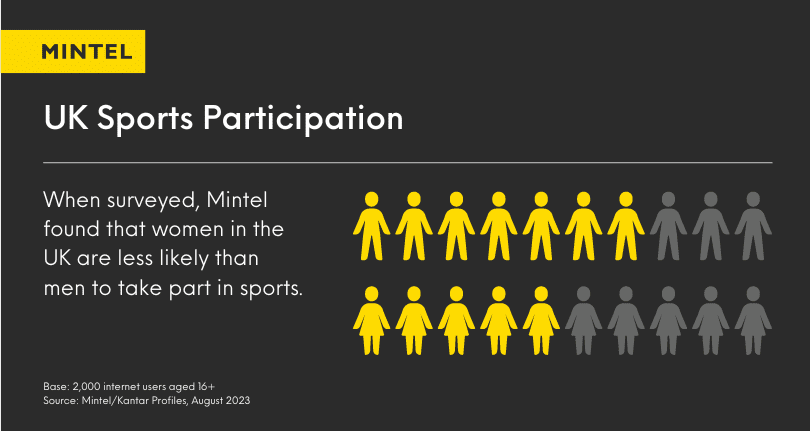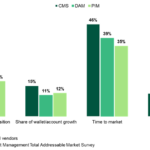On a balmy, late August afternoon in 2023, the Women’s Southern Brave cricket team secured a victory in the Hundred Women’s Competition Final at Lord’s, London. This win marked the culmination of a successful month-long tournament, featuring 32 matches.
But the most significant victory isn’t on the scoreboard. Overall attendance reached a record-breaking 300,000 spectators, with eight Hundred matches making it into Sky Sports’ top 10 most-watched women’s events of the year. These figures signal change and the reimagining of spectator sports.
So what’s driving the reimagining of spectator sports as we know it?
Women’s sports are at an early, albeit momentous, growth stage in terms of volume and value. The focus on accessibility and visibility are core influential factors that are not only driving this growth but also addressing the cost sensitivity that the current economic climate has brought to the leisure market.
Not only that, but the rise of women’s sports is using its newfound freedom to fracture away from male-dominated structures by introducing new formats and fan experiences that promote gender equality in sports. This innovation is poised to reshape the future of sports. Moreover, the increased visibility of women’s sports is crucial for inspiring women and girls to participate in sports activities.
Join Mintel as we explore the evolving landscape and trends making women’s sports more popular, the economic impact, the challenges faced, and how brands can effectively support the growth of women’s sports in 2024 and beyond.
Why are Women’s Sports Becoming More Popular?
In the spotlight: Increased media coverage of women’s sports
One of the biggest factors driving expanded interest in women’s sports in the UK is the increased media coverage and the broadcasting of major events on free-to-air television. Historically, women’s sports received minimal coverage, however, the shift towards more equitable and respectful coverage is influencing consumers’ interest. The significance of visibility cannot be denied, with 48% of Brits agreeing that seeing women’s sports on television incentivises them to watch it.
Analysis by the Women’s Sport Trust charity shows that the 2023 football Women’s World Cup event generated a staggering 262 million viewing hours across the BBC and ITV. This year, the Paris Olympic Games will be the key major event for women in sports as the first edition to feature equal numbers of male and female athletes. To further enhance visibility and keep awareness of women in sports growing strongly, organisers of the Games have designed the schedule to ensure women’s events are as visible as men’s in prime-time viewing slots.
However, brands shouldn’t rely on a one-prong approach to generating interest among fans. Just as television viewing tends to attract older viewers, the value of broadcast coverage in driving interest in women in sports follows a similar trend. Correspondingly, younger audiences are more likely to be attracted by what they see on social media with over a third of 16-24-year-olds agreeing that content on social media piques their interest in women’s sports. With this being said, brands operating in the women in sports space need a multi-channel media strategy to maximise their reach. This would involve segmenting their potential audiences and targeting them in ways that appeal to their generational tastes.
Breaking barriers: Why women in sports matters
The rise of women’s sports can be attributed in part to the emergence of female athletes as role models, brand ambassadors and social media influencers. Four-fifths of Brits view female athletes as positive role models for girls, and women’s sports are increasingly seen as promoting equality, diversity, and inclusion among three-quarters of 28-34-year-olds. This shift is drawing new audiences to international spectator sports, moving beyond the traditionally male-dominated environment. However, it is important to note that while people view women’s sports as a positive force for social change, there is less expectation for individual athletes to champion specific, social causes. Their achievements in a traditionally male arena, inherently contributing to gender equality in sports, are celebrated, making them even more relatable role models for young girls.

Consequently, women’s sports present a valuable platform for brands seeking to align themselves with values of equality and respect, appealing to a growing consumer preference for companies that promote fairness and share their values. The on-field achievements and competitions will continue to garner attention, and nurturing star athletes through sponsorships and brand partnerships offers long-term benefits for brands. By leveraging these athletes’ relatability and inspiring stories, brands can connect with passionate fans and continue to drive interest. Women’s sports fans in the US are demonstrably more passionate than general sports fans, with six in 10 describing themselves as such. This passion translates into a strong desire for increased media coverage at major events like the Olympics and support for their teams and leagues. Ultimately, brands operating in the women in sports space can benefit from a deep well of goodwill, fueled by the positive image of female athletes.
She Shoots, She Scores! The Economic Power of Women in Sports
The cost of living crisis has not only failed to halt the rise of women’s sports attendance but may, in fact, have helped it. In the spectator sports market, interest in major events and the relative affluence of key demographics have provided some resilience against the worst effects of difficult economic conditions. However, looking ahead, Mintel forecasts suggest a dip in UK consumer spending on spectator sports in 2024 to £1,450 million from £1,563 million in 2023, primarily due to economic factors such as high inflation and rising interest rates. This is when the affordability of women’s sports will shine through. Positioned as a cheaper alternative to elite men’s competition, women’s athletics and women’s sports leagues offer strong appeal as a trading-down option while times are tough. Additionally, it provides a sampling opportunity which can capture new fans in a leisure market that is increasingly value-focused.
Explore Mintel’s Extensive Sports Market Research
The appeal of new sporting formats
One of the most exciting opportunities available to women in the sports market lies in leveraging its freedom from traditional, male-dominated structures to create new, innovative formats and fan experiences. Beyond the tangible potential of reshaping the future of sports, these new formats are attracting new fans, increasing visibility, and offering unique experiences that set them apart from traditional layouts, thereby boosting investment for women in sports.
The Hundred Cricket franchise, featuring both men’s and women’s matches on the same day, helps to normalise and encourage female audiences, making the overall audience more inclusive and family-friendly. This dual-gender format helps to level gender equality in sports, boosting the visibility of women in sports all the while encouraging additional consumer spend.
Female competitions are in the process of balancing the adoption of traditional rules and formats to help integrate into the mainstream market while undergoing significant changes to differentiate themselves from men’s sports culture. Leading the way, football’s Women’s Super League and Women’s Championship aim to create new investment models by becoming independent of the FA from the 2024/25 season. Additionally, innovative formats like the King’s League, a Spanish social media-based seven-a-side football competition, and its sister event, the Queens League, are reaching beyond mainstream entertainment. Mintel’s Spectator Sports Report found that among 16-24-year-olds, awareness of Kings League was higher among women than men. This indicates that new, social media-driven formats can effectively engage new fans and expand the audience base for women’s sports.
Breaking free of old conventions could unlock a huge opportunity for women’s sports to create new competitive formats that maximise quality and excitement while fostering new narratives and rivalries that will engage new fans, build mass audiences, and encourage spending.
What are the Biggest Challenges Facing Women’s Sports?
In both the UK and the US women’s participation in sports generally lags behind men’s across various age groups. In the UK for instance, Mintel found that women are less likely to participate in team sports compared to their male counterparts (9% vs. 31% of men). The participation gap is also evident in the US. Mintel’s Teens and Tween Sports Report reveals that boys are more engaged in organised youth sports, such as basketball, baseball and football, compared to girls. Additionally, women are more likely to engage in individual and keep-fit sports rather than team sports. This lack of female participation in team sports can negatively impact the attraction and attendance of women’s sports, as it needs to appeal to those without a pre-existing interest.

Participation in sports is a crucial factor in generating interest in watching sports. When individuals actively engage in sports, they are more likely to develop a connection to the sport, fostering a desire to watch and support it. Therefore, increasing sports participation among women can lead to a larger, more engaged audience for women’s sports.
However, brands are making headway to close the gap. As explored in Mintel’s US Women’s Sports: Spotlight on Fans Report, community outreach projects are essential in increasing girl’s sports participation. By collaborating with grassroots initiatives, teams and women’s sports leagues can provide educational resources and promote physical activity among young girls. These programs also create a pipeline of future athletes and fans and help to foster long-term economic benefits in women’s sports, as evidenced by initiatives from WNBA Cares, NWSL Nationwide Community Impact Program and others.
Additionally, campaigns like Sport England’s “This Girl Can” aim to reduce the exercise enjoyment gap between genders by making sports more social, suitable, self-affirming, and safe for women. By promoting a positive and inclusive environment, such initiatives encourage more women to participate in sports, which in turn can increase interest and attendance in women’s sporting events.
How Can Brands Best Support Women in Sports?
As unpacked in this article, there are numerous strategies that brands can implement to help play a significant role in promoting and supporting women’s sports. Below, we summarise the key initiatives that Mintel’s experts recommend for building a more equitable and inclusive sports industry:
- Invest in media coverage
Brands can partner with media companies to ensure more games are broadcasted on prime channels and at prime times. Greater visibility in mainstream media will help build a larger fan base. - Sponsor female athletes as brand ambassadors and amplify achievements
Through advertising, sponsorships and social media campaigns, brands can highlight the achievements and provide a platform to showcase female talent that can help close the gender fan gap. - Support grassroots and youth initiatives
Investing in grassroots programs and youth initiatives can help build a strong foundation for future generations of female athletes.
Looking Towards the Future with Mintel
Increased media coverage has been instrumental in propelling women’s sports into the mainstream, further bolstered by their affordability during economic downturns. As brand partnerships and sponsorships flourish, investment in women’s sports is poised to blossom.
By pioneering innovative formats, women’s sports have the potential to capture a whole new audience – one that prioritises inclusivity and family-friendliness. However, the journey doesn’t end here. Securing a new horizon for women’s sports requires a multi-pronged approach. Sustained investment is necessary at the grassroots level to nurture young talent and impactful brand campaigns that inspire girls to participate and become the future generation of athletes will continue to support the early, albeit, sizeable growth of the women in sports market.
Subscribe to Mintel’s free newsletter, Spotlight, to get exclusive content and insights delivered directly to your inbox.
Sign up to Spotlight








